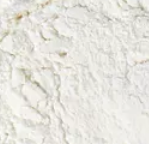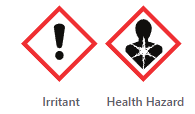E407 (Carrageenan) is a natural, high molecular weight, highly sulphated linear polysaccharide extracted from the edible red algae Rhodophycea and the hydrophilic colloid Kappaphycus alvarezii. It is also extracted from Irish moss Chondrus crispus and Gigartina stellata. The basic unit of carrageenan is D-galactose and 3,6-anhydro-D-galactose. Refined sulphated carrageenan has recently been introduced commercially.
Industrially, it appears in the form of a white to yellowish water-soluble, odourless powder.

What it is used for and where
Mainly used as an emulsifying, stabilising, gelling, film-forming ingredient in foods, cosmetics and parapharmaceuticals.
Medical
Phytochemical analysis of carrageenan has shown the presence of alkaloids, saponins, steroids, gums, mucilages and carbohydrates in both native and commercial carrageenan with antioxidant activities (1).
Food
In European food additives it is labelled with the number E407 as a thickener. Used as a stabiliser, gelling agent, binder and thickener in processed meat and poultry products. It improves the freeze-thaw ratio, stability, flavour and cuttability in poultry products.
Carrageenan has the property of maintaining the organoleptic and structural values of fat-free cheese and can replace casein in cheese imitations and stabilise the structure in cheese-like products (2).
Lightening agent in beverages. Incorporated into confectionery products such as gummy sweets, ice cream and food jelly it can replace agar, pectin and gelatine.
A 2024 study warns about the risk of developing cancer with high intakes of emulsifiers, (including E440, Pectin, E471 mono- and diglycerides of fatty acids, carrageenan, E407, sodium carbonate E500) (3).
Safety
A rather debated ingredient in recent years by toxicology studies and chronic toxicological tests (4).
Carrageenan studies
Typical commercial product characteristics Carrageenan
| Appearance | White powder |
| pH | 8- 11 (1% solution) |
| PSA | 394.53000 |
| Sulfate | 15- 40% |
Loss on drying
| 12 Max% |
| Viscosity (1.5%, 75°C, mPa.s ) | 5 min |
| Gel Strength (1.5% w/w, 0.2% KCl, 25°C, g/cm2) | 1500 min |
| Transparency | 75 min |
Plate Count
| 5000cfu/g max |
Total ash
| 15%~40% |
Acid insoluble ash
| 1.0% Max |
Acid Insoluble matter
| 5.0% Max |
| Lead | 5 mg/kg Max |
| Arsenic | 3 mg/kg Max |
| Mercury | 1 mg/kg Max |
| Cadmium | 1 mg/kg Max |
Total Heavy Metals (as Pb)
| 10 mg/kg Max |
Yeasts & Moulds
| 300 cfu/g Max |
| Safety |  |
- Molecular Formula C23H23Fn4O7Zn
- Molecular Weight 788.65
- Exact Mass 788.09900
- CAS 9000-07-1 11114-20-8
- UNII DV181E4639
- EC Number 232-524-2
- DSSTox Substance ID DTXSID3020255
- IUPAC zinc;1-(5-cyanopyridin-2-yl)-3-[(1S,2S)-2-(6-fluoro-2-hydroxy-3-propanoylphenyl)cyclopropyl]urea;diacetate
- InChI=1S/C19H17FN4O3.2C2H4O2.Zn/c1-2-15(25)11-4-5-13(20)17(18(11)26)12-7-14(12)23-19(27)24-16-6-3-10(8-21)9-22-16;2*1-2(3)4;/h3-6,9,12,14,26H,2,7H2,1H3,(H2,22,23,24,27);2*1H3,(H,3,4);/q;;;+2/p-2/t12-,14+;;;/m1.../s1
- InChl Key UHVMMEOXYDMDKI-JKYCWFKZSA-L
- SMILES CCC(=O)C1=C(C(=C(C=C1)F)C2CC2NC(=O)NC3=NC=C(C=C3)C#N)O.CC(=O)[O-].CC(=O)[O-].[Zn+2]
- MDL number MFCD00081480
- PubChem Substance ID
- FEMA 2596
- RTECS FI0704000
Synonyms
- kappa-Carrageenan
- k-Carrageenan
- Carrageenan Kappa Refined
- Carrageenan Kappa Semi-refined
References_______________________________________________________________
(1) Suganya AM, Sanjivkumar M, Chandran MN, Palavesam A, Immanuel G. Pharmacological importance of sulphated polysaccharide carrageenan from red seaweed Kappaphycus alvarezii in comparison with commercial carrageenan. Biomed Pharmacother. 2016 Dec;84:1300-1312.
(2) Błaszak BB, Gozdecka G, Shyichuk A. Carrageenan as a functional additive in the production of cheese and cheese-like products. Acta Sci Pol Technol Aliment. 2018 Apr-Jun;17(2):107-116. doi: 10.17306/J.AFS.0550.
(3) Sellem, L., Srour, B., Javaux, G., Chazelas, E., Chassaing, B., Viennois, E., ... & Touvier, M. (2024). Food additive emulsifiers and cancer risk: Results from the French prospective NutriNet-Santé cohort. Plos Medicine, 21(2), e1004338.
Abstract. Emulsifiers are widely used food additives in industrially processed foods to improve texture and enhance shelf-life. Experimental research suggests deleterious effects of emulsifiers on the intestinal microbiota and the metabolome, leading to chronic inflammation and increasing susceptibility to carcinogenesis. However, human epidemiological evidence investigating their association with cancer is nonexistent. This study aimed to assess associations between food additive emulsifiers and cancer risk in a large population-based prospective cohort.
(4) David S, Shani Levi C, Fahoum L, Ungar Y, Meyron-Holtz EG, Shpigelman A, Lesmes U. Revisiting the carrageenan controversy: do we really understand the digestive fate and safety of carrageenan in our foods? Food Funct. 2018 Mar 1;9(3):1344-1352. doi: 10.1039/c7fo01721a.
Tobacman JK. Review of harmful gastrointestinal effects of carrageenan in animal experiments. Environ Health Perspect. 2001 Oct;109(10):983-94. doi: 10.1289/ehp.01109983.


![]() E407
E407